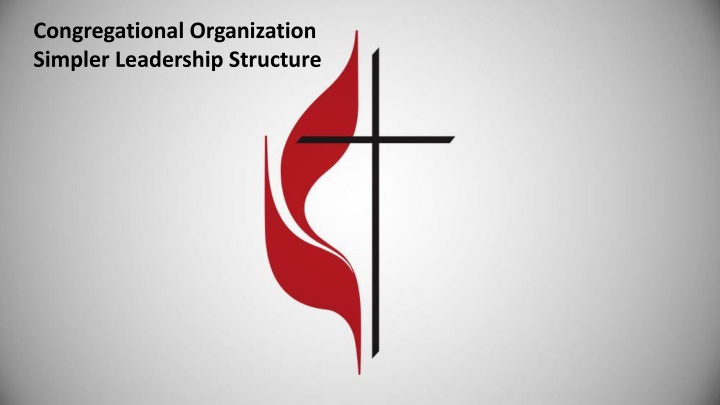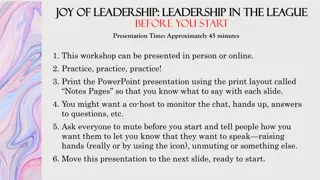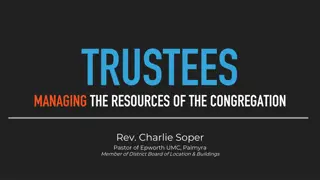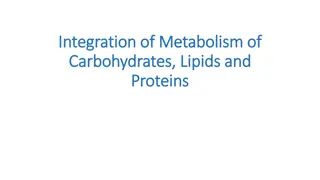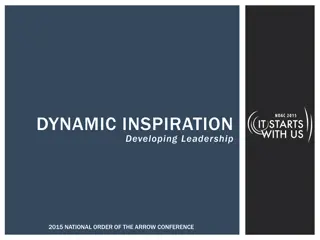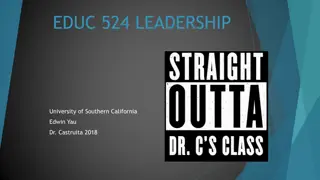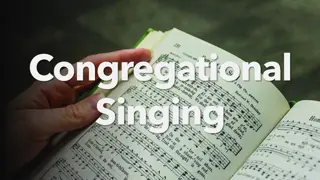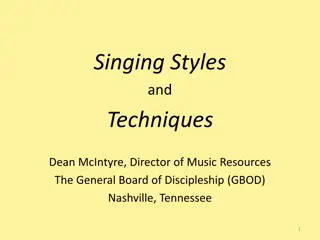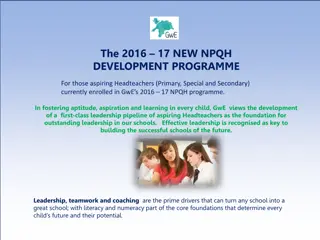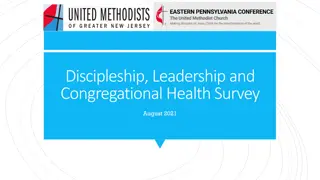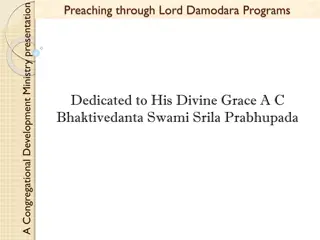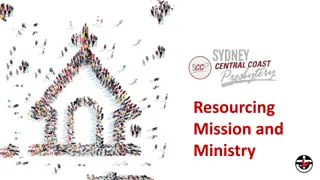Congregational Organization for Simpler Leadership Structure
The congregational organization emphasizes primary tasks such as outreach, spiritual formation, and support for faithful disciples. It outlines responsibilities for effective leadership, financial support, and inclusiveness in church life. Required committees and officers, including Trustees, Pastor/Parish Relations, and Church Council, play vital roles. The Church Council follows a single-board model with specific roles and membership criteria to ensure effective governance.
Download Presentation

Please find below an Image/Link to download the presentation.
The content on the website is provided AS IS for your information and personal use only. It may not be sold, licensed, or shared on other websites without obtaining consent from the author.If you encounter any issues during the download, it is possible that the publisher has removed the file from their server.
You are allowed to download the files provided on this website for personal or commercial use, subject to the condition that they are used lawfully. All files are the property of their respective owners.
The content on the website is provided AS IS for your information and personal use only. It may not be sold, licensed, or shared on other websites without obtaining consent from the author.
E N D
Presentation Transcript
Congregational Organization Simpler Leadership Structure
243. Primary TasksThe local church shall be organized so that it can pursue its primary task and mission in the context of its own community reaching out and receiving with joy all who will respond; encouraging people in their relationship with God and inviting them to commitment to God s love in Jesus Christ; providing opportunities for them to seek strengthening and growth in spiritual formation; and supporting them to live lovingly and justly in the power of the Holy Spirit as faithful disciples.
243. (continued) In carrying out its primary task, it shall be organized so that adequate provision is made for these basic responsibilities: (1) planning and implementing a program of nurture, outreach, and witness for persons and families within and without the congregation; (2) providing for effective pastoral and lay leadership; (3) providing for financial support, physical facilities, and the legal obligations of the church; (4) utilizing the appropriate relationships and resources of the district and annual conference; (5) providing for the proper creation, maintenance, and disposition of documentary record material of the local church; and (6) seeking inclusiveness in all aspects of its life. See 247.2
Disciplinary Required Committees and Officers Trustees 3 to 9 persons 2/3rd must be professing members Pastor/Parish Relations 5 to 9 persons all professing members Plus Lay Leader and Lay Member Church Council Council Chair Treasurer Secretary Lay Member to Annual Conference Lay Leader Nominations and Leadership Development 3 to 9 persons all professing members Plus Lay Leader and Lay Member Finance Membership not defined in Discipline Auditor Counting Teams Financial Secretary
Church Council Single Board Model Alternate Formula SPRC/PPRC 3 Members Trustees 3 Members Program and Finance Chair Treasurer Lay Leader Lay Member Nominations Pastor serves as chair 3 9 members Recommend that majority of members are not on the council
252.5 Membership on the Church Council The membership shall include but not be limited to the following: a) the chairperson of the church council; b) the lay leader; c) the chairperson and/or a representative of the pastor-parish relations committee; d) the chairperson and/or a representative of the committee on finance; e) the chairperson and/or a representative of the board of trustees; f) the church treasurer; g) a lay member to annual conference; h) the president and/or a representative of the United Methodist Men; i) the president and/or a representative of the United Methodist Women; j) a young adult representative k) a representative of the United Methodist Youth; l) the pastor(s).
Church Council Single Board Model Simple Formula Membership: Chairperson of the Council Recording Secretary Treasurer (if not paid) Lay Leader/Lay Member to Annual Conference (could be one person or two different people) Representatives: UMW and UMM (if applicable) Finance Chair Property Chair (Trustees) Personnel Chair (SPRC) Young Adult (if available) Youth (if available) Pastor Nominations Pastor serves as chair 3 9 members Recommend that majority of members are not on the council
Questions for breakout groups: What did you hear? What two questions does your group have? *Put these in the chat as your group returns
RESOURCES Mission Possible 3+: A Simple Structure for Missional Effectiveness (Expanded 3rd Addtion) by Kate Kotan & Blake Bradford Simplified Accountable Leadership Structure
Why a Single Board? 1. Reflect the reality of the size of the congregation not enough leaders and too many positions to fill. 2. Reflect the current realities of available time of church members 3. Streamline the administrative work of the church to free people up to engage in other ministry. 4. Move from idea to action more effectively 5. Reduces the number of meetings 6. Creates a more efficient decision making process.
Why Not a Single Board? 1. Eliminate troublesome leaders from leadership positions 2. Tighten up control over ministry 3. To give more authority to the good leaders 4. To only do administrative/finance work -
Disciplinary Restrictions Trustees: While persons under 18 may participate in discussions, they may not vote as per state law If there are more than 9 persons on the Council, only nine are designated as voting members of the Trustees this should be designated by office, not by specific persons. Suggestions for designating who is voting on Trustees matters when numbers are limited: Council Chair becomes a non-voting member Pastor is a non-voting member (note pastors are always non-voting members unless elected by the Charge/Church conference as one of the nine voting members) SPRC: Limit of nine members plus Lay Leader and Lay Member to Annual Conference No two members of the same family living in the same household may serve on the committee No staff member or staff/pastor s family may serve on the committee Suggestions for dealing with this: Designate the SPRC (personnel) as a sub-committee ahead of time so that restrictions about membership are dealt with. Separate out SPRC specific items from Church Council agenda and handle these either at the beginning or end of meeting so that other members of the Council who are not designated as SPRC can excuse themselves.
Process 1. Develop a Plan with the Church Council that meets Disciplinary Requirements 2. Approval of plan by the District Superintendent 3. Approval by Church/Charge Conference Can be done at Special CC or Regular Create a Nominations Report consistent with the new plan
Potential Issues with a Single Board? 1. Limited number of people in decision making process 2. Concentration on administrative matters and not program of nurture, outreach and witness 3. Can limit possibilities for engaging new persons in leadership or considering new ideas 4. Small group of persons controlling all ministries
Dealing with Potential Issues 1. Pre-defined process of rotation of members with mandatory term limits 2. Development of agenda that puts priority on the ministries of the church with other matters to follow 3. Use of task forces and short term teams for ministry opportunities. 4. Create a culture that allows people to do and expand ministry without having to come back to the council for permission
